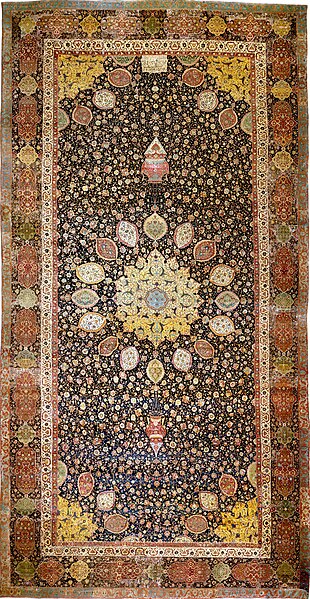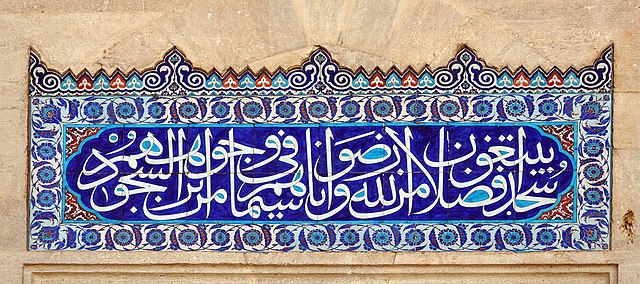The arabesque is a form of artistic decoration consisting of "surface decorations based on rhythmic linear patterns of scrolling and interlacing foliage, tendrils" or plain lines, often combined with other elements. Another definition is "Foliate ornament, used in the Islamic world, typically using leaves, derived from stylised half-palmettes, which were combined with spiralling stems". It usually consists of a single design which can be 'tiled' or seamlessly repeated as many times as desired. Within the very wide range of Eurasian decorative art that includes motifs matching this basic definition, the term "arabesque" is used consistently as a technical term by art historians to describe only elements of the decoration found in two phases: Islamic art from about the 9th century onwards, and European decorative art from the Renaissance onwards. Interlace and scroll decoration are terms used for most other types of similar patterns.

Stone relief with arabesques of tendrils, palmettes and half-palmettes in the Umayyad Mosque, Damascus, Syria
Part of a 15th-century ceramic panel from Samarkand (Uzbekistan) with white calligraphy on a blue arabesque background
Mosaics on the Treasury Dome of the Great Mosque of Damascus, 789, still in essentially Byzantine style
Palace facade from Mshatta in Jordan, c.740, now in the Pergamon Museum (Berlin)
Islamic art is a part of Islamic culture and encompasses the visual arts produced since the 7th century CE by people who lived within territories inhabited or ruled by Muslim populations. Referring to characteristic traditions across a wide range of lands, periods, and genres, Islamic art is a concept used first by Western art historians in the late 19th century. Public Islamic art is traditionally non-representational, except for the widespread use of plant forms, usually in varieties of the spiralling arabesque. These are often combined with Islamic calligraphy, geometric patterns in styles that are typically found in a wide variety of media, from small objects in ceramic or metalwork to large decorative schemes in tiling on the outside and inside of large buildings, including mosques. Other forms of Islamic art include Islamic miniature painting, artefacts like Islamic glass or pottery, and textile arts, such as carpets and embroidery.

Detail of arabesque decoration at the Alhambra in Spain
The Ardabil Carpet, probably the finest surviving Persian carpet, Tabriz, mid-16th century
Hunters at a Stream - Riza `Abbasi, c. 1625 Brooklyn Museum
Tiles with some calligraphy in the courtyard of the Süleymaniye Mosque in Istanbul (Turkey)








